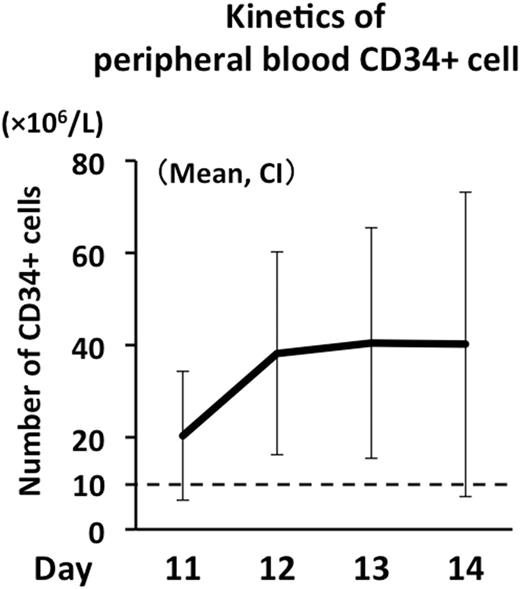Abstract

Introduction: Hematopoietic stem cell rescue with autologous peripheral blood stem cells (PBSC) following high-dose chemotherapy has been used for the treatment of lymphoma and myeloma. Granulocyte colony-stimulating factor (G-CSF) is used for PBSC mobilization but data on PBSC mobilization by pegfilgrastim is limited. Recent studies showed successful PBSC harvest by single dose of pegfilgrastim given at 6mg or 12mg within 4 days after chemotherapy in patients with malignant lymphoma. However, administration of pegfilgrastim early after chemotherapy administration induces overshoot of neutrophils, which may result in rapid plasma clearance of G-CSF due to internalization of the G-CSF/G-CSF receptor complexes via endocytosis in neutrophils. Previous studies demonstrated that day 7 injection of pegfilgrastim in the course of chemotherapy mitigated the neutrophil overshoot compared to day 4 injection of pegfilgrastim. We hypothesized that day 7 administration of lower dose 3.6mg pegfilgrastim could avoid neutrophil overshoot and efficiently mobilize PBSCs. Here we show the kinetics of CD34+ PBSC mobilization after 3.6mg pegfilgrastim given on day 7 in the course of chemotherapy.
Patients and Methods: Between February 2016 and May 2017, twenty patients with malignant lymphoma enrolled in this study (14 DLBCL, 2 AITL, 2 ALCL, 1 ATLL, 1 FL). Median age was 54 (range 30-65). Eight patients had clinical stage III-IV. Median number of prior chemotherapy was 0 (range 0-2). All patients received cytotoxic chemotherapy (13 CHOP, 2 DeVIC, 2 ESHAP, 1 DHAP, 1 EPOCH, 1 HD-AraC) on day 1 and 3.6mg of pegfilgrastim was administered subcutaneously on day 7. Peripheral blood CD34+ cell counts were analyzed from day 11 to 14 after chemotherapy by flowcytometric analysis using single platform method based on ISHAGE guideline. The primary objective is to clarify the kinetics of peripheral blood CD34+ cells without harvesting intervention. CD34+ values on each time point is statistically tested using one-sample t-test. To visualize the primary result, bar graph with mean and its confidence interval on each day is represented with the reference line (Figure). The secondary objectives are to search peak point of CD34+ cell counts after each chemotherapy regimen and the feasibility of pegfilgrastim administration on day 7. Successful mobilization was defined as to achieve more than 10×106/L peripheral blood CD34+ cells on any time points between day 11 and 14. All patients were assessed for toxicity according to the National Cancer Institute Common Toxicity Criteria, version 4.0. This study was approved by the institutional review board and conducted in accordance with the Declaration of Helsinki.
Results: Successful mobilization was achieved in 19 of the 20 patients (95%). Mean number (SD) of WBC (×109/L) on each day between day 11 and day 14 was 5.4 (3.7), 11.4 (9.1), 14.2 (9.1) and 13.9 (7.4), respectively. Mean number (SD) of CD34+ cells (×106/L) on each day between day 11 and day 14 was 20.3 (22.5), 38.0 (35.7), 40.3 (39.8), and 40.1 (53.5), respectively. The 98.75% confidence interval [CI] of CD34+ cells (×106/L) on each day between day 11 and day 14 was [6.39-34.22], [16.16-60.25], [15.77-64.97] and [7.09-73.16], respectively (Figure). The number of CD34+ cells on day 12 or 13 showed significantly higher than 10×106/L CD34+ cell ( P = 0.0022 and 0.0030, respectively) (Figure). We then compared the peak of CD34+ cells in a peripheral blood in each chemotherapy regimens. The peak day of CD34+ cell in patients who received CHOP regimen was day 13 (mean 54.3 ×106/L, range 15.8-151.0×106/L) . However, in 4 of 5 patients who received platinum containing regimen, CD34+ cells failed to reach the peak before day 14 because of prolonged myelosuppression. The number of prior chemotherapy regimen (0 vs 1-2) was not associated with the kinetics of CD34+ cells ( p = 0.35). No infectious events including febrile neutropenia were observed. Pain and LDH elevation (Grade 1-2) were the main adverse events related to pegfilgrastim administration. We had not detected any severe adverse events.
Conclusion: Our data indicated that 3.6mg pegfilgrastim on day 7 can efficiently mobilize CD34+ cells to peripheral blood without any severe adverse events.
Teshima: Novartis: Consultancy, Membership on an entity's Board of Directors or advisory committees, Research Funding; Astellas: Research Funding; Kyowa-Hakko Kirin: Research Funding; Pfeizer: Research Funding; Chugai: Research Funding; Bristol-Myers Squibb: Research Funding; Takeda: Consultancy, Membership on an entity's Board of Directors or advisory committees, Research Funding.
Author notes
Asterisk with author names denotes non-ASH members.

This icon denotes a clinically relevant abstract


This feature is available to Subscribers Only
Sign In or Create an Account Close Modal